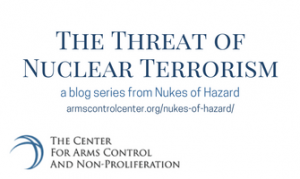Masked beneath the humor and heart that made the 1985 movie, Back to the Future, such a classic, is the very real issue of nuclear security and nuclear terrorism.
The movie begins with a newscast in the background:
“In other news, officials at The Pacific Nuclear Research Facility have denied the rumor that the case of missing plutonium was in fact stolen from their vault two weeks ago. A Libyan terrorist group had claimed responsibility for the alleged theft; however, the officials now attribute the discrepancy to a simple clerical error.”
A few scenes later, protagonist Marty McFly is filming his friend, scientist Emmett Brown (Doc), as he helps with his latest experiment, a time machine built from a DeLorean.
Marty: This is uh, this is heavy duty, Doc, this is great. Uh, does it run on regular unleaded gasoline?
Doc: Unfortunately, no, it requires something with a little more kick: plutonium.
Marty: Uh, plutonium, wait a minute, are you telling me that this sucker’s nuclear?
Doc: Hey, hey, keep rolling, keep rolling there. No, no, no, no, this sucker’s electrical. But I need a nuclear reaction to generate the 1.21 gigawatts of electricity that I need.
Marty: Doc, you don’t just walk into a store and ask for plutonium. Did you rip this off?
Doc: Of course. From a group of Libyan nationalists. They wanted me to build them a bomb, so I took their plutonium and in turn gave them a shiny bomb case full of used pinball machine parts.
In our most recent lesson in former Secretary of Defense William J. Perry’s course, “The Threat of Nuclear Terrorism,” we covered a lot of ground, as usual. We learned about the history of proliferation, and how it was an Irish delegate to the United Nations who first proposed a non-proliferation treaty in 1958. We discussed Pakistan and North Korea as potential sources of materials, technology and intelligence for terrorists hoping to acquire nuclear weapons. We learned that the first four nuclear bombs ever created were identical because of a spy who was sharing information with several countries. We discussed A.Q. Khan, creator of a one-stop shop for Pakistan’s nuclear arsenal. I’ve heard him referred to as the nuclear smuggling equivalent of a Walmart: parts, plans, widgets — he sold them all.
Throughout the class, the idea of “loose nukes” struck me, and I immediately thought of this movie. Doc Brown stole nuclear material and created a mobile loose nuke. Were the Libyans the only ones who knew? Why weren’t the Feds on his tail? Should Marty have alerted someone? The plutonium was stolen from the research facility — did the facility say it was a clerical error to prevent the public panic that knowing a Libyan terrorist group stole plutonium would have caused? If lightning can also create the 1.21 gigawatts of electricity needed, as we learn later in the movie, can the Doc find a way to use that for future time travel and return the plutonium to the facility?
The term “loose nukes” was coined to refer to former Soviet nuclear weapons that lacked adequate security and could in theory be stolen by rogue regimes or non-state actors. Today, we also think of loose nukes as unsecured nuclear bomb making materials that could fall into the wrong hands — like those of a foreign terrorist group, or even a scientist they’d hire.
Nuclear security is an issue that had never really crossed my mind before taking this job — and this class. As naïve as it sounds now, I thought there was little difference between countries that had nuclear weapons and countries that had nuclear materials. And I had never given much thought to non-state actors acquiring the materials. It’s perfectly logical (and, as I’m learning, it’s also feasible and likely), but it just never crossed my mind.
The loose nukes problem, we learned, also applies to the brains behind nuclear weapons. If scientists on state payrolls feel they are not being adequately compensated or just wish to take their talents elsewhere, they could turn to terrorist groups who are willing to shell out big bucks for someone who can help them accomplish their goals.
A few weeks ago, our senior policy analyst at the center, Sara Z. Kutchesfahani, wrote an op-ed detailing the need for nuclear security to be a priority in President Donald Trump’s forthcoming Nuclear Posture Review — a report that details an Administration’s nuclear priorities. The more I learn about nuclear weapons and nuclear terrorism, the more this seems like a no-brainer to me. This has to be one step in the long and complex process to keep nuclear materials safe and secure and out of the wrong hands. That would include the hands of a lovable and eccentric time-traveling scientist.


